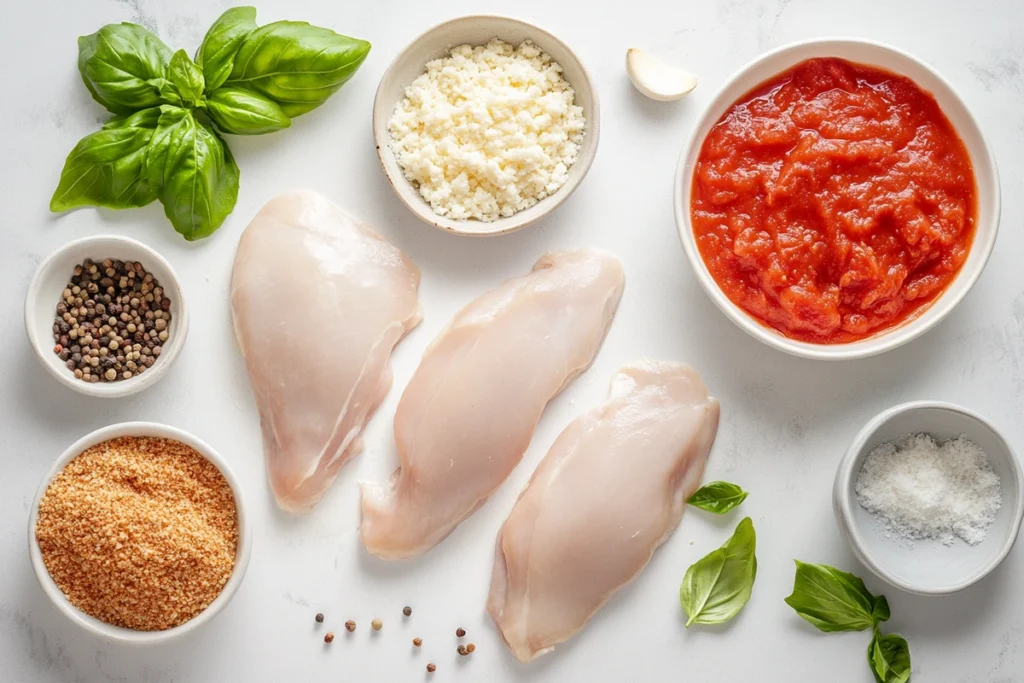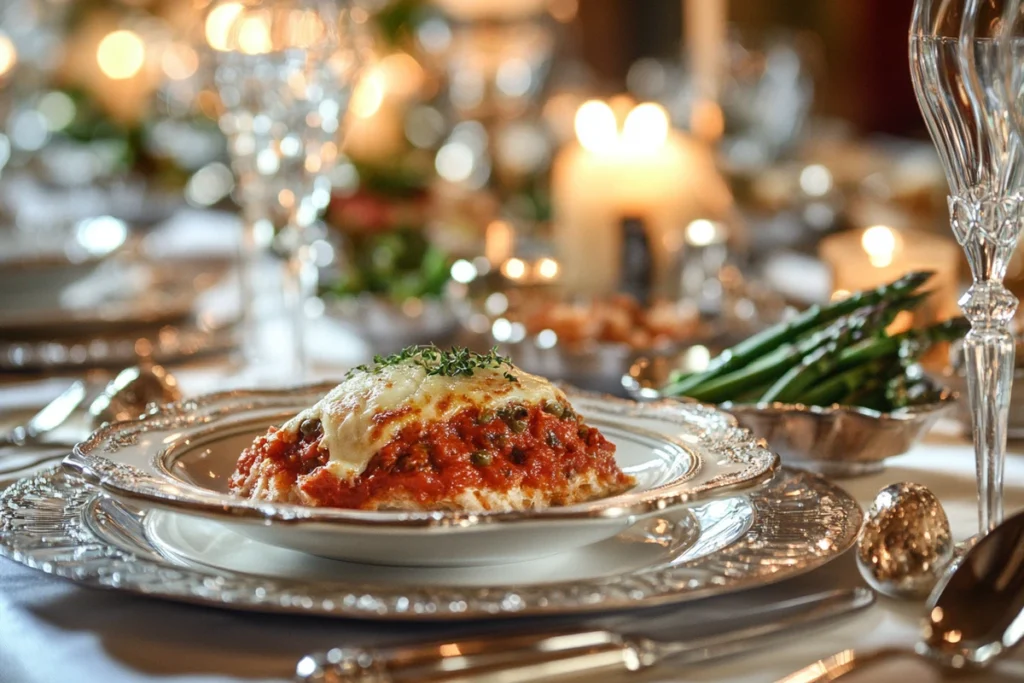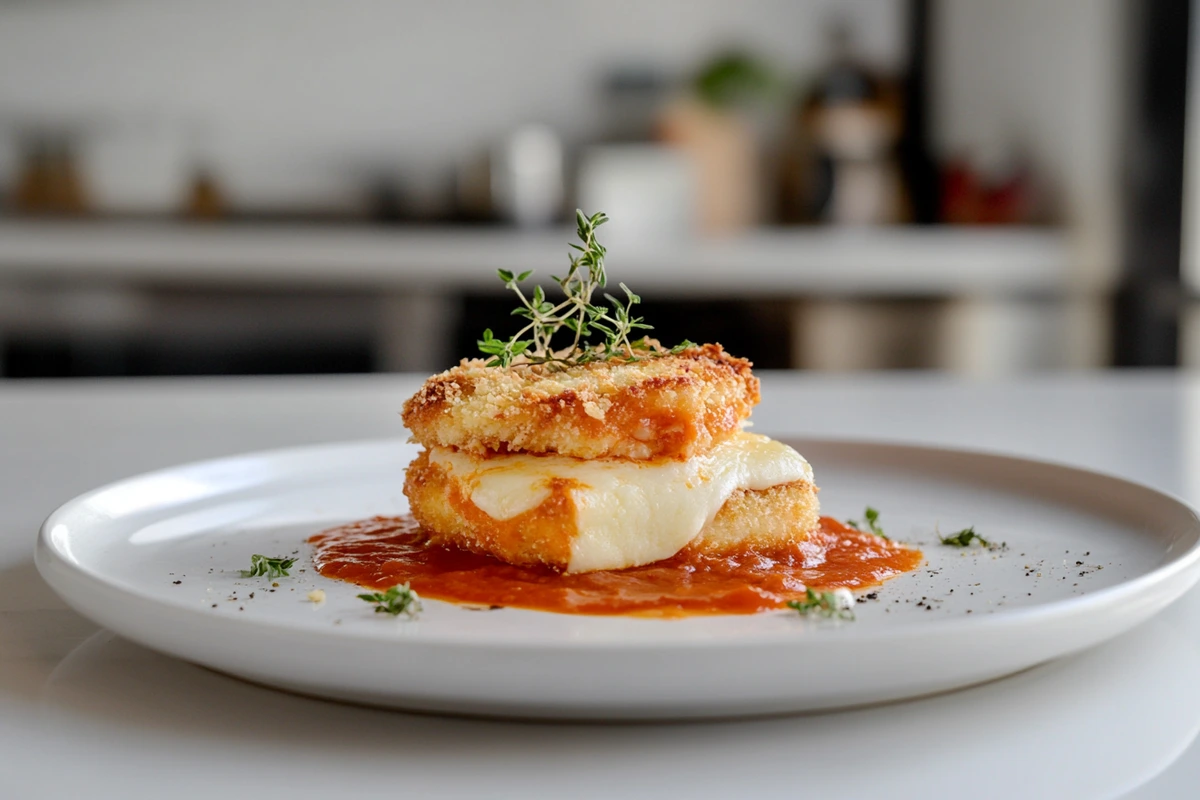Discover how to make a chicken parmesan recipe that combines tender chicken, tangy tomato sauce, and melted cheese for a comforting experience.
Introduction
Create a delightful chicken parmesan recipe at home with our step-by-step guide. Enjoy a perfect balance of flavors in this beloved Italian-American dish.
I. Understanding the Chicken Parmesan Recipe
The chicken parmesan recipe originated from Italian-American traditions, eventually becoming a staple in homes across the United States. It features breaded chicken cutlets baked with tomato sauce and cheese, offering a savory taste that appeals to people of all ages. Basically, the dish is known for its crisp coating, tangy sauce, and cheesy topping. Indeed, it has stood the test of time in various forms. Another reason for its popularity is its versatility. You can prepare it with simple methods or introduce modern twists for added excitement.
A. Definition and Key Elements
Chicken parmesan recipe revolves around three main components:
- Breaded Chicken: Typically, boneless chicken breasts are pounded thin.
- Tomato Sauce: A simple sauce with tomatoes, onions, garlic, and seasonings.
- Cheese Topping: Usually mozzarella, sometimes combined with Parmesan or provolone.
The breaded chicken is pan-fried or baked, then covered in sauce and cheese. Finally, it’s cooked further until the cheese melts. Consequently, the final product showcases tender chicken, tangy sauce, and gooey cheese. Likewise, some prefer a more herbaceous sauce, while others stick to a simpler blend.
B. Origins and Popularity
This chicken parmesan recipe found its way from Southern Italian cooking to the broader American public through Italian immigrants. However, the dish in Italy is commonly known as “Parmigiana,” usually made with eggplant. Nevertheless, chicken soon replaced eggplant for a protein-rich twist. Undoubtedly, this new version caught on quickly in American households. Eventually, it appeared in restaurants nationwide, thereby elevating it to iconic status. In fact, you can now find many variations, including baked, pan-fried, or grilled approaches.
II. Exploring the Best Chicken Parmesan Recipe Basics

This chicken parmesan recipe revolves around high-quality chicken, flavorful sauce, and the right cheese. Indeed, paying attention to each component significantly affects the final dish. By selecting fresh ingredients, you can ensure that every bite bursts with flavor. Whereas using cheaper products might result in a lackluster outcome. Therefore, it’s crucial to know what to look for when shopping.
A. Selecting Quality Chicken
- Boneless Breasts: They’re common because they cook evenly and remain juicy when prepared properly.
- Organic or Free-Range: These often boast better flavor.
- Pound the Chicken: Flattening helps the meat cook more uniformly, ensuring a tender bite.
Many home cooks skip pounding the chicken, yet it’s a simple step that has a big impact. Particularly, an evenly thin piece means quicker, more consistent cooking. Equally important, it helps keep your chicken from drying out. Moreover, you can cut large chicken breasts into halves if they’re too big to manage.
B. Preparing a Flavorful Sauce
The tomato sauce is the heart of this chicken parmesan recipe. After all, it unifies the dish’s elements. Consider the following tips:
- Use Crushed Tomatoes: Many people choose either fresh tomatoes or high-quality canned ones.
- Sauté Aromatics: Onions and garlic give depth and complexity.
- Add Seasonings: Basil, oregano, salt, and pepper are typical. Meanwhile, a pinch of red pepper flakes can add subtle heat.
Eventually, this sauce should simmer until slightly thickened. Additionally, some prefer a chunkier texture, while others opt for a smoother consistency. Comparatively, both approaches can yield great results, so it depends on your personal preference. You might also consider adding a splash of balsamic vinegar for extra tang.
C. Choosing the Right Cheese
Cheese is another key part of this chicken parmesan recipe. Customarily, mozzarella is the go-to. Meanwhile, Parmesan cheese adds salty complexity. Other home cooks use provolone for more flavor. Still, mozzarella’s mild taste allows the tomato sauce to shine.
- Mozzarella: Typically, low-moisture mozzarella melts evenly without making the dish too watery.
- Parmesan: Offers a distinct nutty flavor, especially when using authentic Parmigiano-Reggiano.
- Provolone: Provides a smoky character if you need something different.
Consequently, mixing cheeses can lead to a multilayered taste. Nonetheless, moderation is important. An overabundance of cheese can mask the chicken’s flavor.
III. Chicken Parmesan Recipe Tips and Techniques
A successful chicken parmesan recipe demands attention to small details. Indeed, subtle steps can mean the difference between a good meal and a stellar one. The process includes preparing the chicken cutlets, creating a crisp coating, and finishing the dish with the right baking method. Next, we’ll delve into each step thoroughly.
A. Breading the Chicken
For maximum crunch, breading typically involves three stages:
- Flour: Coats the chicken and helps the egg adhere.
- Egg Wash: Ensures the breadcrumb layer sticks well.
- Breadcrumbs: Often a combination of plain breadcrumbs and grated Parmesan cheese.
Particularly, seasoning each layer is vital. Consequently, you’ll avoid bland spots. Use salt, pepper, and perhaps dried herbs. Meanwhile, some prefer panko breadcrumbs for added crunch.
B. Pan-Frying or Baking
Cooking methods vary, so choose based on your preference for crispiness or convenience:
- Pan-Frying: Results in a crispy exterior. Use enough oil to submerge at least half the thickness of each cutlet.
- Baking: Reduces oil usage, but you must ensure that your oven is adequately preheated. Drizzle or spray the breaded chicken with oil to promote browning.
Conversely, some cooks combine both. For instance, they lightly pan-fry to brown and then transfer the chicken to the oven. This approach ensures a crisp crust without overcooking.
C. Adding the Sauce and Cheese
After cooking the chicken, you’ll top it with sauce and cheese:
- Sauce Over the Top: Spoon your prepared tomato sauce. Spread it evenly across the chicken.
- Sprinkle Cheese: Place mozzarella slices or shredded cheese on top.
- Gratinate: Return the chicken to the oven or broiler to melt the cheese.
Meanwhile, ensure the sauce isn’t too watery. A soggy crust diminishes the texture you worked hard to achieve. Finally, let the cheese brown slightly for extra flavor.
D. Ensuring Proper Cooking Time
Cook chicken until it reaches an internal temperature of 165°F. Generally, an instant-read thermometer helps confirm doneness. Overcooking leads to dryness, while undercooking poses food safety risks. Therefore, monitor the cooking process carefully, adjusting times based on chicken thickness.
IV. Three Chicken Parmesan Recipe
1. Chicken Parmesan Recipe Basics
This chicken parmesan recipe starts with fresh chicken breasts, quality breadcrumbs, and a robust sauce. Initially, season the cutlets and prepare a simple assembly line for breading: flour, egg, and breadcrumbs. Consequently, the final product retains a hearty crust.
2. Chicken Parmesan Recipe Variations
Every home cook can personalize their chicken parmesan recipe. You can incorporate diverse cheeses, add roasted peppers, or introduce sun-dried tomatoes for extra zest. Additionally, consider using spicy tomato sauce for a bolder taste.
3. Chicken Parmesan Recipe Pairings
Deciding how to serve your chicken parmesan recipe is equally important. Comparatively, a quick side salad and roasted vegetables provide a balanced meal. Alternatively, you can serve it with noodles or Zucchini Pasta for a low-carb twist.
V. Three Chicken Parmesan Recipe
1. Preparing the Chicken Parmesan Recipe Ahead
One advantage of a chicken parmesan recipe is its make-ahead potential. Basically, you can prepare the breaded cutlets and refrigerate. Then, top with sauce and cheese right before cooking. Consequently, mealtime becomes much simpler.
2. Serving the Chicken Parmesan Recipe for Special Events
Hosting a dinner party or family gathering can be stressful. Luckily, a chicken parmesan recipe suits large groups. Indeed, you can cook in large trays, layering the sauce and cheese as needed. Meanwhile, it remains easy to slice and serve.
3. Storing Leftover Chicken Parmesan Recipe
Leftovers from a chicken parmesan recipe should be cooled and refrigerated promptly. Indeed, the crispness might diminish, but the taste remains intact. Reheat in the oven for best results, reviving the cheese and sauce. Meanwhile, you can slice leftover chicken and serve in sandwiches or wraps.
VI. Serving Ideas and Plate Presentation

Presentation matters, especially if you’re preparing the dish for guests. A bright garnish of fresh basil leaves or parsley can add color. Meanwhile, plating on a white dish helps the red sauce and golden cheese stand out. Another option is to drizzle extra tomato sauce in an artistic pattern around the plate.
Additionally, including complementary sides ensures a balanced meal. You could serve Avocado Toast with Feta as an appetizer. Or, if you prefer, offer Vegetarian Tortilla Soup as a starter. Undoubtedly, these pairings bring variety and round out the meal.
VII. Nutritional Considerations
This chicken parmesan recipe can be adapted to meet various dietary needs. Generally, using low-fat cheese and baking instead of frying reduces calorie intake. Another tactic is to serve with vegetable sides to increase nutrient density. Comparatively, gluten-free breadcrumbs let you cater to individuals with specific dietary restrictions.
However, some indulgence is part of the dish’s appeal. Because the core elements (chicken, sauce, cheese) define the classic flavor, moderation is key. You might add more vegetables or reduce cheese if you want a lighter approach. Meanwhile, enjoy the occasional splurge without guilt.
VIII. Frequently Asked Questions
What’s the difference between chicken parmesan and chicken parmigiana?
Essentially, both refer to a similar dish. Chicken parmesan and chicken parmigiana are nearly identical. They both involve breaded chicken topped with sauce and cheese, though some people use the names interchangeably. The term “parmigiana” stems from Italian roots, while “parmesan” is the anglicized version.
What is a good side with chicken parmesan?
A variety of sides can complement chicken parmesan. Many enjoy pasta or a light salad. Some prefer roasted vegetables. In addition, a creamy polenta or mashed potatoes also pairs well. Ultimately, the best side depends on your taste and the occasion.
How do you get breading to stick to chicken parmesan?
Ensuring your breading stays in place is straightforward. First, pat the chicken dry. Next, coat it in flour, then dip in beaten egg, and finally press it into breadcrumbs. This triple-layer approach helps the breading adhere. Meanwhile, avoid overcrowding during frying or baking.
Is a chicken parmigiana healthy to eat?
Chicken parmigiana can be part of a balanced diet when eaten in moderation. Indeed, it contains protein from chicken and calcium from cheese. However, the breading and cheese add calories. If you want a lighter option, bake instead of fry. Also, choose reduced-fat cheese or incorporate more vegetables on the side.
IX. Conclusion
A well-made chicken parmesan recipe stands as a testament to classic Italian-American cooking. With a crisp breading, tangy sauce, and melted cheese, the dish satisfies on many levels. Consequently, it remains a favorite for family meals, casual gatherings, and even special occasions. By mastering the essential techniques, adapting the recipe to your preferences, and serving it alongside complementary dishes, you can enjoy a delicious and memorable meal. Embrace the warmth and tradition that chicken parmesan recipe brings to your table, and keep experimenting with new flavors and presentations.

